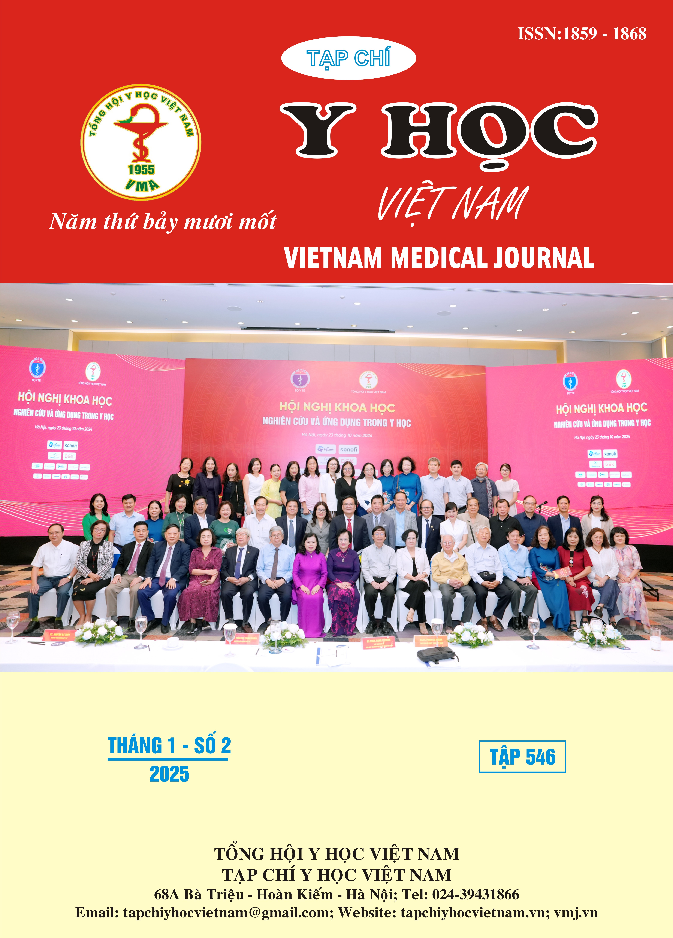SURVEY OF CLINICAL AND PARACLINICAL CHARACTERISTICS OF PATIENTS WITH EXCURSIVE PLEURAL EFFUSION
Main Article Content
Abstract
Objective: The study has objectives: Describe the clinical and paraclinical characteristics of patients with exudative pleural effusion at the Department of Internal Medicine and Respiratory Medicine, Can Tho Central General Hospital. Methods: A cross-sectional retrospective study design on 97 patients admitted to the Department of Internal Medicine and Respiratory Medicine, Can Tho Central General Hospital with a diagnosis of exudative pleural effusion from January 2023 to January 2024. Result: Clinical and paraclinical characteristics: Patients were admitted to the hospital with the most common reason being chest pain (59.8%) and the onset time was usually ≤15 days. The prominent functional and systemic symptoms were pleuritic chest pain (89.7%) and common symptoms of pleural effusion were dyspnea (80.4%), dry cough (58.8%), and fever (33%). The physical symptoms recorded during examination were mainly trichotillomania (100%) and pulmonary rales (25.8%). Regarding paraclinical characteristics, the majority were unilateral pleural effusion (84.5%), free (95.9%) and moderate in volume (43.3%). Associated lung parenchymal lesions on standard chest X-ray accounted for 61.9%. Most patients with exudative pleural effusion in the study had normal leukocyte formula (61.9%). The majority of pleural effusion in our study was lemon yellow (77.3%) with average protein, LDH, cell count, lymphocyte and neutron ratios of 49.20 g/l, 707.18 U/L, 1348.86 leukocytes/mm3, 81.03% and 18.97%, respectively, 30.9% had the presence of foreign cells in the pleural effusion and a high negative pleural effusion PCR rate (92.8%). In 97 cases that underwent cell-block and biopsy, 49.5% of cases had carcinoma cells in the pleural fluid and the biopsy results mostly showed carcinoma (48.5%), followed by tuberculous inflammation (41.2%) and chronic inflammation (10.3%). The complication rate after blind pleural biopsy was low, with only chest pain at the biopsy site (8.2%) and hematoma at the biopsy site (1%).
Article Details
Keywords
clinical, paraclinical, patient, secretory pleural effusion.
References
2. Nguyễn Xuân Kiên (2015), Nghiên cứu đặc điểm lâm sàng, cận lâm sàng của tràn dịch màng phổi hai bên tại Trung tâm Hô hấp Bệnh viện Bạch Mai, Luận văn tốt nghiệp Bác sĩ đa khoa, Trường Đại Học Y Hà Nội, Hà Nội.
3. Vũ Văn Kiều (2020), Đặc điểm lâm sàng, cận lâm sàng và nguyên nhân tràn dịch màng phổi dịch tiết tại Bệnh viên Bạch Mai, Luận văn Thạc sĩ Y học, Trường Đại Học Y Hà Nội, Hà Nội.
4. Ferreiro L., Toubes M. E., San Jose M. E., Suarez-Antelo J., Golpe A., Valdes L. (2020), "Advances in pleural effusion diagnostics", Expert Rev Respir Med, 14, (1), p. 51-66.
5. Jany B, Welte T (2019), "Pleural Effusion in Adults-Etiology, Diagnosis, and Treatment", Dtsch Arztebl Int, 116, (21), p. 377-386.
6. Light R.W. (2007), "Tuberculous pleural effusion", Pleural Disease, Lippincott Wililiams and Wilkins, p. 211-224.
7. Rachana Krishna, Marsha H Antoine, Mohan Rudrappa (2023), Pleural Effusion, StatPearls, Treasure Island (FL), https://www.ncbi.nlm. nih.gov/books/NBK448189/.
8. Nidhi Sanwalka, Ramesh Kumar, Madhvi Sanwalka (2020), "Role of pleural biopsy in patients of undiagnosed exudative pleural effusion", International Journal of Medical Research and Review, 8, (3), p. 265-268.


